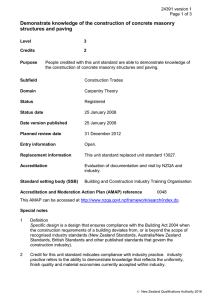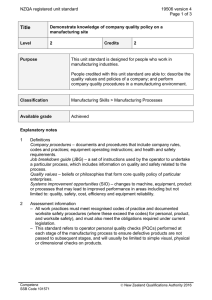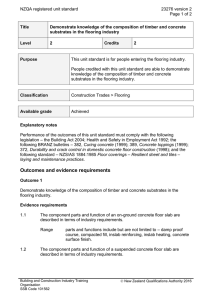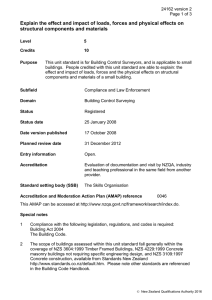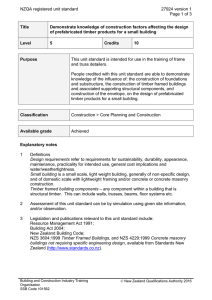NZQA registered unit standard 27157 version 1 Page 1 of 4
advertisement
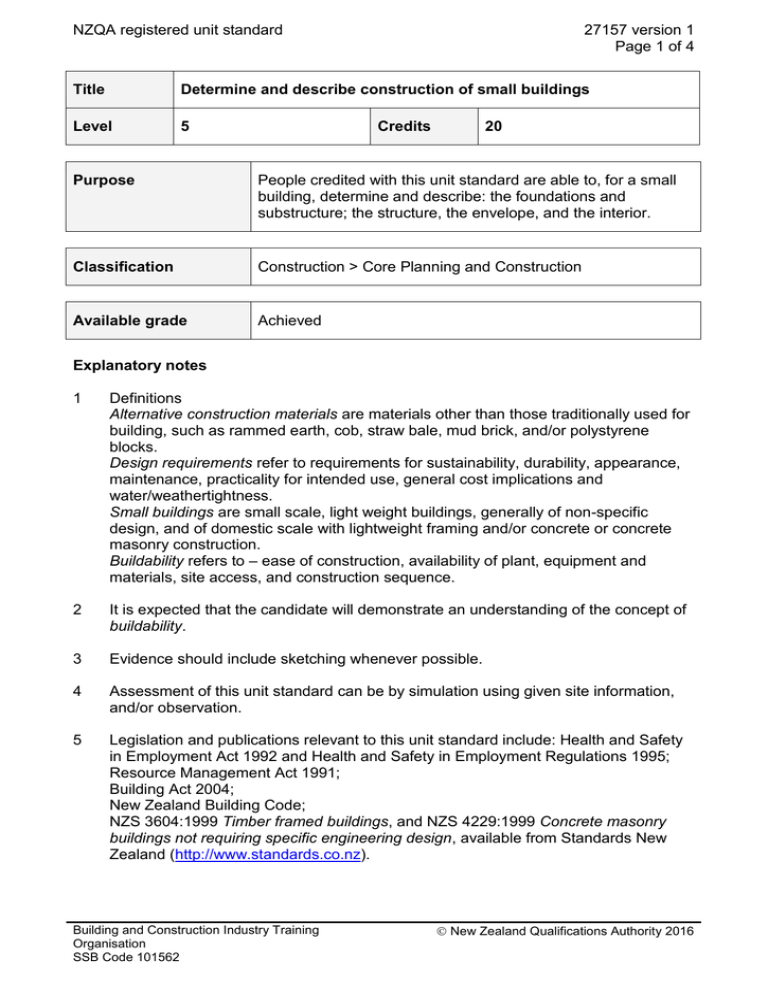
NZQA registered unit standard 27157 version 1 Page 1 of 4 Title Determine and describe construction of small buildings Level 5 Credits 20 Purpose People credited with this unit standard are able to, for a small building, determine and describe: the foundations and substructure; the structure, the envelope, and the interior. Classification Construction > Core Planning and Construction Available grade Achieved Explanatory notes 1 Definitions Alternative construction materials are materials other than those traditionally used for building, such as rammed earth, cob, straw bale, mud brick, and/or polystyrene blocks. Design requirements refer to requirements for sustainability, durability, appearance, maintenance, practicality for intended use, general cost implications and water/weathertightness. Small buildings are small scale, light weight buildings, generally of non-specific design, and of domestic scale with lightweight framing and/or concrete or concrete masonry construction. Buildability refers to – ease of construction, availability of plant, equipment and materials, site access, and construction sequence. 2 It is expected that the candidate will demonstrate an understanding of the concept of buildability. 3 Evidence should include sketching whenever possible. 4 Assessment of this unit standard can be by simulation using given site information, and/or observation. 5 Legislation and publications relevant to this unit standard include: Health and Safety in Employment Act 1992 and Health and Safety in Employment Regulations 1995; Resource Management Act 1991; Building Act 2004; New Zealand Building Code; NZS 3604:1999 Timber framed buildings, and NZS 4229:1999 Concrete masonry buildings not requiring specific engineering design, available from Standards New Zealand (http://www.standards.co.nz). Building and Construction Industry Training Organisation SSB Code 101562 New Zealand Qualifications Authority 2016 NZQA registered unit standard 6 27157 version 1 Page 2 of 4 It is recommended that the outcomes of this unit standard be achieved in conjunction with Unit 9663, Demonstrate knowledge of a research/feasibility study of a site. Outcomes and evidence requirements Outcome 1 Determine and describe the foundations and substructure for a small building. Evidence requirements 1.1 Description addresses geotechnical factors. 1.2 Description is in accordance with building use and design requirements. 1.3 Construction process is explained in terms of site constraints, materials, and time and general cost implications. Range materials – timber, concrete, steel. Outcome 2 Determine and describe the structure of a small building of non-specific design. Evidence requirements 2.1 Description includes provision for services, materials, cladding and finishes. 2.2 Description is in accordance with building use and design requirements. 2.3 Construction process is explained in terms of site constraints, materials, and time and general cost implications. Range materials – timber, in-situ reinforced concrete, concrete masonry blockwork. Outcome 3 Determine and describe the structure of a small building of specific design. Evidence requirements 3.1 Description includes provision for services, materials, cladding and finishes. 3.2 Description is in accordance with building use and design requirements. Building and Construction Industry Training Organisation SSB Code 101562 New Zealand Qualifications Authority 2016 NZQA registered unit standard 3.3 27157 version 1 Page 3 of 4 Construction process is explained in terms of site constraints, materials, and time and general cost implications. Range materials – timber, structural steel, reinforced concrete, steel stud, concrete masonry blockwork, any alternative construction materials. Outcome 4 Determine and describe the envelope of a small building. Evidence requirements 4.1 Selection and design for wall and roof claddings and openings matches the characteristics of the required structure. Range materials, four of – timber, rendering, metal sheet, cellulose cement, masonry, concrete, glass. 4.2 Design principles of typical cladding jointing systems are described in terms of sealants, flashings, and compatibility and jointing between systems. 4.3 Description includes provision for services, materials, and finishes. 4.4 Description is in accordance with building use and design requirements. 4.5 Construction process is explained in terms of site constraints, materials, and time and general cost implications. Range materials, four of – timber, rendering, metal sheet, cellulose cement, masonry, concrete, glass. Outcome 5 Determine and describe the interior of a small building. Range linings, joinery, fitments. Evidence requirements 5.1 Selection of the interior matches the characteristics of the required structure. 5.2 Description matches or exceeds the regulatory requirements that apply to the approved solutions. 5.3 Description includes provision for services, materials, and finishes. 5.4 Construction process is explained in terms of site constraints, materials, and time and general cost implications. Building and Construction Industry Training Organisation SSB Code 101562 New Zealand Qualifications Authority 2016 NZQA registered unit standard 27157 version 1 Page 4 of 4 Replacement information This unit standard replaced unit standard 9671. Planned review date 31 December 2015 Status information and last date for assessment for superseded versions Process Version Date Last Date for Assessment Registration 1 18 March 2011 N/A Accreditation and Moderation Action Plan (AMAP) reference 0048 This AMAP can be accessed at http://www.nzqa.govt.nz/framework/search/index.do. Please note Providers must be granted consent to assess against standards (accredited) by NZQA, or an inter-institutional body with delegated authority for quality assurance, before they can report credits from assessment against unit standards or deliver courses of study leading to that assessment. Industry Training Organisations must be granted consent to assess against standards by NZQA before they can register credits from assessment against unit standards. Providers and Industry Training Organisations, which have been granted consent and which are assessing against unit standards must engage with the moderation system that applies to those standards. Consent requirements and an outline of the moderation system that applies to this standard are outlined in the Accreditation and Moderation Action Plan (AMAP). The AMAP also includes useful information about special requirements for organisations wishing to develop education and training programmes, such as minimum qualifications for tutors and assessors, and special resource requirements. Comments on this unit standard Please contact the Building and Construction Industry Training Organisation national.office@bcito.org.nz if you wish to suggest changes to the content of this unit standard. Building and Construction Industry Training Organisation SSB Code 101562 New Zealand Qualifications Authority 2016


